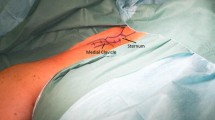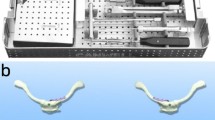Abstract
Background
Posterior sternoclavicular dislocations are common in younger patients and are frequently due to high energy sporting incidents.
Aim
We aim to demonstrate a novel technique that is safe and aims to provide good functional post-operative outcomes for patients with this injury.
Methods
This was a single-surgeon case series of four young patients from October 2017 to July 2019. The operative technique involved relocating the joint and holding it in situ with nylon suture tape. The tape was anchored in holes drilled in the sternum and passed through tunnels drilled into the medial clavicle. All of the patients were contacted retrospectively and a Nottingham Clavicle Score (NCS) was performed for each patient on a post-operative basis.
Results
No intra-operative or post-operative complications were noted. All of the patients demonstrated a significant improvement in their functional outcomes after the operation. The average NCS for the four patients was 82/100.
Discussion
There are a variety of techniques described in the literature to repair this ligament using either plates or tendon grafts. All of these techniques describe the drilling of anteroposterior holes in the manubrium and clavicle which run the intra-operative risk of perforating a major vessel. This paper is the first one to describe a technique which uses superior inferior holes which minimizes the risks, making the procedure safer for the patient.
Conclusions
We believe this novel technique is safer than the existing described techniques, and it does not compromise on functional outcomes.





Similar content being viewed by others
Availability of data and material
All of the data are available on request.
Code availability
This data was analysed using Microsoft Excel.
References
Wirth MA, Rockwood CA (1996) Acute and chronic traumatic injuries of the sternoclavicular joint. J Am Acad Orthop Surg 4(5):268–278. https://doi.org/10.5435/00124635-199609000-00005
Sewell MD, Al-Hadithy N, Le Leu A, Lambert SM (2013) Instability of the sternoclavicular joint: current concepts in classification, treatment and outcomes. Bone Joint J 95-B(6):721–31. https://doi.org/10.1302/0301-620X.95B6.31064
Renfree KJ, Wright TW (2003) Anatomy and biomechanics of the acromioclavicular and sternoclavicular joints. Clin Sports Med 22(2):219–237. https://doi.org/10.1016/s0278-5919(02)00104-7
Nettles JL, Linscheid RL (1968) Sternoclavicular dislocations. J Trauma 8(2):158–164. https://doi.org/10.1097/00005373-196803000-00004
Franck WM, Jannasch O, Siassi M, Hennig FF (2003) Balser plate stabilization: an alternate therapy for traumatic sternoclavicular instability. J Shoulder Elbow Surg 12(3):276–281. https://doi.org/10.1016/s1058-2746(02)86802-1
Hecox SE, Wood GW (2010) Ledge plating technique for unstable posterior sternoclavicular dislocation. J Orthop Trauma 24(4):255–257. https://doi.org/10.1097/BOT.0b013e3181cab11b
Ao R, Zhu Y, Zhou J et al (2018) Locking plate for treating traumatic sternoclavicular joint dislocation: a case series. BMC Musculoskelet Disord 19(1):7. https://doi.org/10.1186/s12891-017-1903-8
Shuler FD, Pappas N (2008) Treatment of posterior sternoclavicular dislocation with locking plate osteosynthesis. Orthopedics 31(3):273. https://doi.org/10.3928/01477447-20080301-35
Martínez A, Rodríguez A, González G et al (1999) Atraumatic spontaneous posterior subluxation of the sternoclavicular joint. Arch Orthop Trauma Surg 119(5–6):344–346. https://doi.org/10.1007/s004020050424
Bae DS, Kocher MS, Waters PM et al (2006) Chronic recurrent anterior sternoclavicular joint instability: results of surgical management. J Pediatr Orthop 26(1):71–74. https://doi.org/10.1097/01.bpo.0000187998.91837.b2
Abiddin Z, Sinopidis C, Grocock CJ et al (2006) Suture anchors for treatment of sternoclavicular joint instability. J Shoulder Elbow Surg 15(3):315–318. https://doi.org/10.1016/j.jse.2005.07.005
Charles ER, Kumar V, Blacknall J et al (2017) A validation of the Nottingham Clavicle Score: a clavicle, acromioclavicular joint and sternoclavicular joint-specific patient-reported outcome measure. J Shoulder Elbow Surg 26(10):1732–1739. https://doi.org/10.1016/j.jse.2017.03.036
Lyons FA, Rockwood CA (1990) Migration of pins used in operations on the shoulder. J Bone Joint Surg Am 72(8):1262–1267
Morell DJ, Thyagarajan DS (2016) Sternoclavicular joint dislocation and its management: a review of the literature. World J Orthop 7(4):244–250. https://doi.org/10.5312/wjo.v7.i4.244
Author information
Authors and Affiliations
Corresponding author
Ethics declarations
Conflict of interest
The authors declare no competing interests.
Additional information
Publisher's Note
Springer Nature remains neutral with regard to jurisdictional claims in published maps and institutional affiliations.
Appendix
Appendix
Full list of Arthrex® InternalBrace™ equipment used:
-
BioComposite SwiveLock®, 3.5 mm × 15.8 mm with #2 FiberTape
-
Tap for 3.5 mm SwiveLock®
-
Drill guide
-
Drill, cannulated, 2.7 mm
-
Drill, 2.7 mm
-
BioComposite SwiveLock®, 4.75 mm × 19.1 mm
-
Tap for 4.75 mm SwiveLock®
-
Drill, 3.4 mm
-
Guide wire with trocar tip, 1.35 mm
-
Free needles, qty. 2
-
Suture passing wire, nitinol, 200 mm
Rights and permissions
About this article
Cite this article
Keohane, D., Morrissey, D. Repair of sternoclavicular joint ligament: a novel approach. Ir J Med Sci 191, 2141–2145 (2022). https://doi.org/10.1007/s11845-021-02826-6
Received:
Accepted:
Published:
Issue Date:
DOI: https://doi.org/10.1007/s11845-021-02826-6




